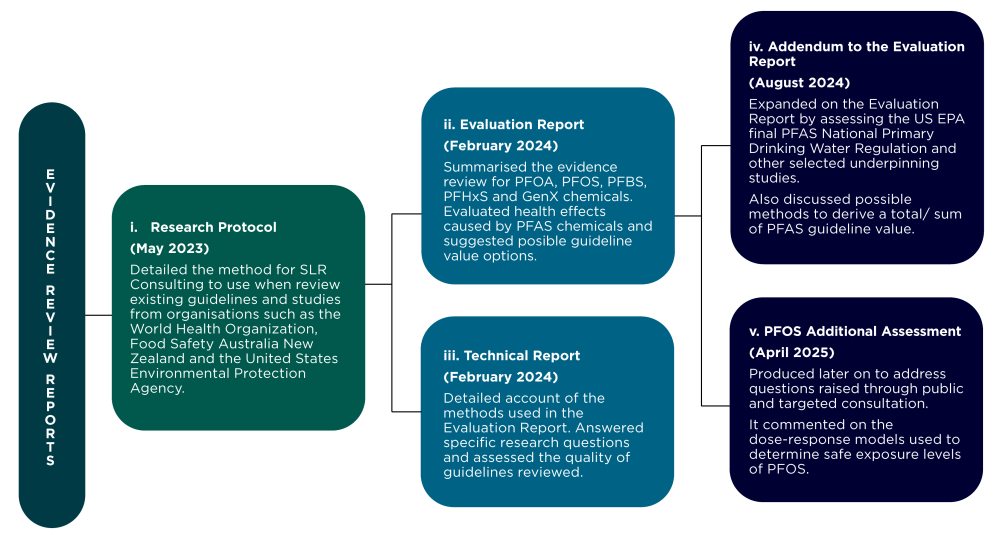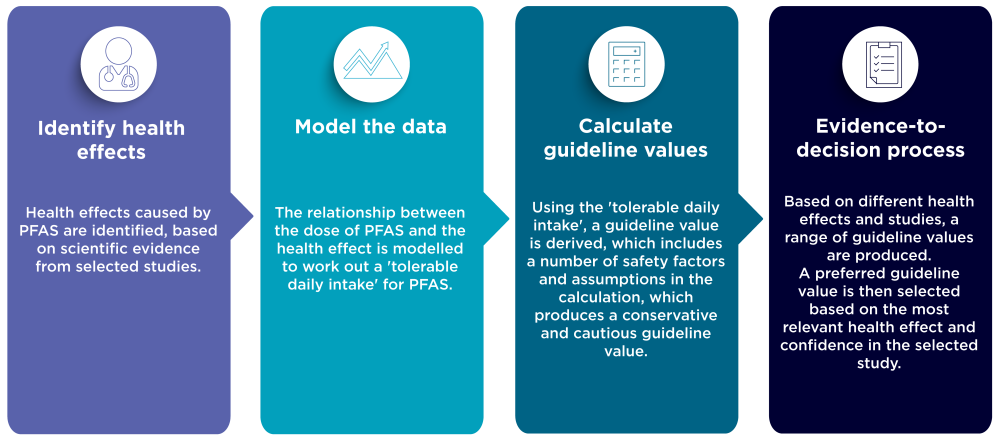This section provides information on the key stages of the review of PFAS in the Australian Drinking Water Guidelines.
Table of contents
Updated PFAS Fact Sheet
The PFAS Fact Sheet in the Australian Drinking Water Guidelines was updated in June 2025 with new information, advice and health based guideline values. A brief outline of the guideline development process is shown in Figure 1.

To ensure the updated PFAS advice was scientifically sound and protective of public health, several quality assurance steps were undertaken:
- Seeking expert advice from the Water Quality Advisory Committee throughout every stage of the process.
- Engaging an independent consultant to critically evaluate the scientific evidence.
- Releasing draft guidance for public and targeted consultation to allow all stakeholders the opportunity to provide meaningful feedback.
- Receiving critical feedback from expert reviewers on the draft guidelines at different stages of its development.
These quality checks reinforce the integrity of the guideline development process. The Administrative Report provides more detailed information on each stage of the review process and explains the rationale behind key decisions.
Key stages of the review
1. Project planning
In June 2022, the United States Environmental Protection Agency (US EPA) issued interim health advisories for PFOA, PFOS, PFBS and GenX chemicals in drinking water. This new health advisory prompted NHMRC to plan a review to update the PFAS Fact Sheet.
NHMRC does not automatically adopt drinking water guidelines from other countries.
When international advice is updated, we check the quality of the review, the scientific evidence, and whether it is relevant for Australian conditions and circumstances.
This is important because other countries, like the United States, have their own legislative frameworks and risk assessment approaches that might not fit Australian needs. It is not unusual for countries to have different guidelines because they use different methods or approaches and focus on different health effects.
For more information, see our PFAS questions and answers.
NHMRC reviewed the health advice for PFOA, PFOS, PFHxS, PFBS and GenX chemicals. Additional PFAS may be reviewed in the future as new toxicological data and high-quality evidence becomes available.
2. Evidence evaluation
SLR Consulting Australia was contracted by NHMRC to evaluate existing guidelines and studies on PFAS in drinking water from both national and international sources. In total, SLR Consulting Australia provided 5 documents as shown in Figure 2.
The findings from the evidence evaluation were used to update the PFAS Fact Sheet, leading to the establishment of new and revised guideline values for PFAS drinking water.

- Figure 2 image description
Flow chart with outline and summary of the 5 evidence review reports.
- Research Protocol (May 2023)
Detailed the method for SLR Consulting to use when review existing guidelines and studies from organisation such as the World Health Organization, Food Safety Australia New Zealand and the United States Environmental Protection Agency. (Flows to 2 and 3.) - Evaluation Report (February 2024)
Summarised the evidence review for PFOA, PFOS, PFBS, PFHxS and GenX chemicals. Evaluation health effects caused by PFAS chemical and suggested possible guideline value options. (Flows to 4 and 5.) - Technical Report (February 2024)
Detailed account of the methods used in the Evaluation Report. Answered specific questions and assessed the quality of guidelines reviewed. - Addendum to the Evaluation Report (August 2024)
Expanded on the Evaluation Report by assessing the US EPA final PFAS National Primary Drinking Water Regulation and other selected underpinning studies. Also discussed possible methods to derive a total/sum of PFAS guideline value. - PFOS Additional Assessment (April 2025)
Produced later on to address questions raised through public and targeted consultation. It commented on the dose-response models used to determine safe exposure levels of PFOS.
- Research Protocol (May 2023)
3. Selection of PFAS guideline values
The evidence review reports provided various guideline options for PFAS in drinking water, based on different health effects and modelled data, and highlighted some as more favourable options. However, these preferred guideline options were not recommendations and were not automatically selected.
Instead, the Water Quality Advisory Committee reviewed these options through an ‘evidence to decision’ process (detailed in Appendix A of the Administrative Report), by considering the reliability of the underlying studies and relevance of the health endpoint to select the most suitable guideline option for the Australian context.

- Figure 3 image description
Flow chart of Steps taken to select a PFAS Guideline Value.
- Identify health effects - Health effects caused by PFAS are identified, based on scientific evidence from selected studies.
- Model the data - The relationship between the dose of PFAS and the health effect is modelled to work out a 'tolerable daily intake' for PFAS.
- Calculate guideline values - Using the 'tolerable daily intake', a guideline value is derived, which includes a number of safety factors and assumptions in the calculation, which produces a conservative and cautious guideline value.
- Evidence-to-decision process - Based on different health effects and studies, a range of guideline values are produced. A preferred guideline value is then selected based on the most relevant health effect and confidence in the selected study.
We assume 10% of PFAS exposure comes from drinking water.
Section 6.3.3 of the Australian Drinking Water Guidelines assumes by default that 10% of our intake of chemicals used commercially or industrially comes from drinking water.
This assumption has been used to set the health-based guideline values for PFAS.
To set the health-based guideline values, we first figure out how much PFAS we can tolerate on a daily basis, from exposure to all sources. We then include in our final health-based guideline calculation an assumption that only 10% of our PFAS exposure comes from drinking water (instead of 20% like the United States Environmental Protection Agency), which results in guideline values that are set lower and are more cautious.
For more information, see our PFAS questions and answers.
What are the health effects of PFAS in humans?
The health effects of PFAS are still not fully understood. Studies on both animals and humans have shown mixed results, and the findings can vary based on the methods and assumptions used.
Some studies have found associations between exposure to certain PFAS chemicals and various biological effects, which include increased cholesterol and uric acid levels in blood and reduced kidney function. It is important to note that these findings are based on associations, meaning they show a relationship between the 2 factors, but do not confirm a direct cause.
NHMRC did not consider the available studies in humans to be sufficiently reliable or appropriate to derive Australian health-based guideline values for PFAS in drinking water. Several limitations of these studies were identified, such as a small sample size, limited dose-response information and the possibility that other chemicals, not only PFAS, might have caused the health effects observed.
NHMRC in consultation with the Water Quality Advisory Committee selected the most suitable evidence-based health effects from high quality animal studies that were well-designed and relevant to human health, to set the different PFAS health-based guideline values, as shown in Table 1.
Do PFAS cause cancer?
The PFAS Review found there is currently no evidence that PFOS, PFHxS, PFBS or GenX chemicals cause cancer. However, there are animal studies that suggest PFOA may cause cancer. Despite this, there was no evidence that PFOA causes damage or permanent changes to genetic material, so the PFOA guideline value was calculated using a ‘threshold’ approach.
This means a guideline value was set, for which cancer effects from PFOA are not expected to occur if PFOA levels stay below this value. This approach aligns with methods used by enHealth and the World Health Organization.
| PFAS | Critical health effect (and associated study) | New resulting guideline value |
|---|---|---|
| PFOA | Potential cancer risk NTP Technical Report (2023) on the Toxicology and Carcinogenesis Studies of Perfluorooctanoic Acid Administered in Feed to Sprague Dawley Rats | 200 nanogram per litre (ng/L) |
| PFOS | Possible bone marrow effects NTP Technical Report (2022) on the Toxicity Studies of Perfluoroalkyl Sulfonates Administered by Gavage to Sprague Dawley Rats | 8 nanogram per litre (ng/L) |
| PFHxS | Potential thyroid effects NTP Technical Report (2022) on the Toxicity Studies of Perfluoroalkyl Sulfonates Administered by Gavage to Sprague Dawley Rats | 30 nanogram per litre (ng/L) |
| PFBS | Potential thyroid effects Feng et al., (2017) Exposure of Pregnant Mice to Perfluorobutanesulfonate Causes Hypothyroxinemia and Developmental Abnormalities in Female Offspring | 1000 nanogram per litre (ng/L) |
| GenX chemicals | Due to the lack of suitable studies to identify a critical health effect, it is currently not possible to establish a health-based guideline value for GenX chemicals. |
4. Public consultation
From October to November 2024, individuals and organisations were invited to share their thoughts on a draft version of the PFAS Fact Sheet through public consultation.
NHMRC reviewed all public consultation submissions with advice from the Water Quality Advisory Committee and actioned feedback accordingly. A summary of the public consultation is available at Appendix E of the Administrative Report, and a document containing the public consultation submissions (where permission has been given to publish) are available to download below.
5. Targeted consultation
In September 2024 and April 2025, the enHealth Water Quality Expert Reference Panel reviewed and provided feedback on the draft PFAS Fact Sheet, before and after public consultation. This panel includes experts from different states and territories who specialise in drinking water quality and public health, ensuring the updated PFAS advice is practical and accurate.
The Department of Health and Aged Care, Food Standards Australia New Zealand, along with other Commonwealth agencies were also consulted on the draft guidance. Based on the feedback received, several changes were made to the draft PFAS Fact Sheet which has been summarised in Appendix B of the Administrative Report.
6. Expert review
Independent experts in the areas of PFAS, water quality, toxicology and environmental health provided a critical review of the draft guidance at various stages of development. The independent experts aimed to determine whether the scientific evidence was evaluated correctly and interpreted accurately. A summary of their comments can be found in Appendix C of the Administrative Report.
7. NHMRC Council and CEO approval
Following finalisation of the PFAS Fact Sheet, NHMRC Council reviewed the PFAS guidance material. Council includes members that have expertise in public health, medical research, consumer issues and business. The Council recommended the updated PFAS Fact Sheet should be published, which the NHMRC CEO approved.
The updated PFAS Fact Sheet was published in the Guidelines on 25 June 2025.